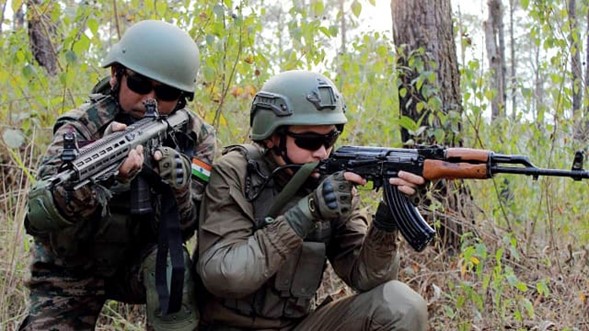
India’s Quest For A Reliable Assault Rifle

In the modern contactless hi-tech warfare, do assault rifles really make that difference? This is a question stuck on the minds of many. In an era of battlefield dominance by missile, drones of all kinds and sizes, to precision & loitering ammunition with beyond the visual range having autonomous homing abilities, where does an assault rifle stand, why is it so important? Is it just the assault rifle or the complete small arms family being operated by any infantry, have a bearing upon the outcome of a battle. If it is that important than has India found a reliable assault rifle for its infantrymen?
In futuristic battlefields of the wars of tomorrow, the warfighting would have undergone a total transformation. The battlefield dynamics is changing faster than the imagination of the best of brains in the field. This change is already being witnessed in Ukraine where technology is shaping the battlefield faster than the tactics itself. The combination of precise geolocation, high-fidelity battlefield awareness, instant communications, and standoff weapons means that militaries by 2040 may no longer need to mass forces in time and space to the extent historically or traditionally deemed necessary to achieve their objectives. Hence the role and tasking will force infantryman to undergo a metamorphosis faster than anyone can imagine. The days of Infantry assaulting objective in extended line with fixed bayonets are over the horizon.
Looking at things purely from futuristic infantryman’s perspective who will be situationally best aware and technologically far more enabled in dealing with any immediate and emerging threats. There lurks a high risk to survival and execution of the mission, if any of the critical enablers like the communications get damaged, disrupted, or destroyed by hostile action. A scenario most likely to occur with one side or the other. Any side that achieves this state over the adversary, will force his overall warfighting system to devolve from an interlinked, cohesive network into a disconnected and broken mosaic incapable of conducting effective combat operations. This implies that the final phase of any battle for control of real estate, will ultimately be fought only by an Infantry man, using his assault rifle in raw display of soldierly skill and courage. Hence the continued importance of an infantry man and his assault rifle as a winning factor at the point of decision.
Assault Rifle Dilemma
Going by the philosophy and technological trends in assault rifles worldwide, India needs to replace its already obsolete, frontline holding, of 5.56 mm INSAS rifle at the earliest. It has been unfortunate that our planners were never ahead of the curve. Indian army realised the obsolesce of its 7.62 SLR only after suffering heavy casualties at the hands of LTTE armed with 7.62 AK 47s in Sri Lanka. India’s defence research did try develop an assault rifle around the NATO’s philosophy of smaller calibre which was light and had higher rate of fire. The INSAS replaced the 7.62mm L1A1 Self Loading Rifle (SLR) but it failed miserably in winning the Infantryman’s confidence. In fact the INSAS was obsolete the day it was introduced. It was an ineffective weapon system against militants operating with AK series assault rifles in Kashmir and the North East. Indian army had no option but to import Kalashnikov and its variants for fighting the insurgencies.
The AK-203 Era
The primary personal weapon for over two decades in service with infantry soldiers, the INSAS will finally be replaced by AK-203. The AK-203 combines excellent ergonomics, adaptability to different shooters and high performance characteristics, it is one of the best assault rifles in the world. The Korwa Ordnance Factory in Amethi has produced the first batch of 7.62 mm Kalashnikov AK-203 assault rifles. The beginning of deliveries to the Indian Army is expected soon. Some 7 lakh such rifles are needed and these would be the main assault rifle for the Indian infantry in years to come.
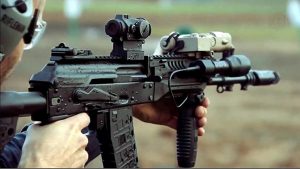
The AK-203 is of Russian origin, gas-operated, rotating bolt, magazine-fed, select fire assault rifle designed to chamber the 7.62×39mm cartridge. It has an astounding rate of fire of 700 rounds per minute. Having a muzzle velocity of 715 meters per second achieves a target hit easily between 400 to 800 meters based on sight adjustments. The AK 203 is fed by two types of magazines, one is the standard 30 rounds detachable box magazine and the other is 50 round detachable quad column magazine. This weapon system has adjustable open iron sights and has picatinny rails for different types of day /night optical sights as attachments.
SIG Sauer 716
With inordinate delays in manufacture of AK 203 weapon system, there was an urgency felt to replace the INSAS, the Indian army decided to procure 7.62mm SIG Sauer 716 assault rifle through Fast Track Procedure (FTP) as a stop gap measure. The Indian Army had revised its operational philosophy in 2016, wherein the 7.62 x 51mm calibre was chosen over the 5.56 x 45mm calibre, as having the optimum calibre for operations. As a result, the SIG 716 Assault Rifle, being of higher calibre (7.62 x 51mm) was selected for the interim. SIG has longer effective range, more lethality and also has a higher recoil.

In February 2019, 72,400 SIG 716 rifles — 66,400 for the army, 4,000 for the air force and 2,000 for the Navy — of 7.62 x 51mm calibre were contracted from SIG Sauer Inc, USA, under the government ‘Buy (Global) category’ through the FTP. Initially it was planned to equip only frontline troops deployed on the Line of Control and the Line of Actual Control. However in a revised thought this weapon system will equip about 100 soldiers each in all infantry battalions irrespective of whether they are in the field or at peace stations.
Future Scenario
Both the weapon systems will coexist in an infantry battalion, the SIG 716 and the AK-203 are from different families, they have different operating systems with different calibre. This adds to logistic chain management and training challenges. Indian troops will however adapt to AK-203 faster in comparison with the SIG. Indian soldier has been using different variants of Kalashnikov for over 30 years now in active battle field environment. Ideally the commonality of ammunition and interoperability within the family of small arms should be the philosophy. However it is difficult to achieve this in our case as it has been demonstrated by Indian Army’s upgradation plan of the existing small arms held by infantry.
Our arch rivals Pakistan and China are also upgrading their family of small arms. Pakistan however appears to be achieving interoperability and commonality of ammunition. Pakistan Ordnance Factories unveiled its new family of BW-20 assault rifles at the World Defence Show (WDS) in Riyadh in March 2022. And the Chinese showcased their new-generation service rifle, the QBZ191 5.8mm automatic rifle at Air show China 2021.
As reported by the Janes, the BW-20 family of rifles comes in three variants – a 12-inch barrelled assault version for urban and close-in fighting roles, 16-inch barrelled version for standard infantry use, and a 20-inch marksman version, which features a modified stock. Chambered for a 7.62×51 mm round, the rifle has a 20-round polymer magazine and utilises a roller-delayed blowback mechanism. This rifle was developed following the requirement for new weapons by the Pakistani military in 2015 to replace the Heckler & Koch G3. The BW-20 retains the roller-delayed mechanism.
On the Chinese weapon systems, the Global Times reported, that new weapons are designed and manufactured by the China South Industries Group Corporation (CSGC). At Air Show China 2021, on display were a shorter and lighter variant of the QBZ191 carbine, the QBZ192, and a designated marksman rifle or high-precision rifle of the 191 series, the QBU 191. Also on display were two new machine guns, the QJB201 5.8mm and QJY201 7.62mm.
It has been claimed that the QBZ-191 uses a conventional configuration with greatly improved ergonomics, ambidextrous usability, and better reliability across different environments when compared to the QBZ-95. The Chinese infantry will have one family of small arms across the spectrum.
Other Weapons with Infantry
In India, while the INSAS rifle is yet to be replaced by AK 203, the INSAS LMG has already been replaced by the Israeli 7.62 x 51 mm NEGEV Light Machine Gun. The Dragnov sniper rifle is being replaced by the SAKO TRG-42 sniper rifle. It is a bolt-action sniper rifle designed and developed by the Finnish gun maker SAKO. The rifle is designed to fire powerful .338 Lapua Magnum-sized cartridges. and weighs at 6.55 kgs without ammunition. It has an effective range of 1,500 metres. The MP9 will equip the Ghataks of the Indian Infantry. The Brugger & Thomet MP9 is a submachine gun chambered for the 9×19mm Parabellum cartridge.
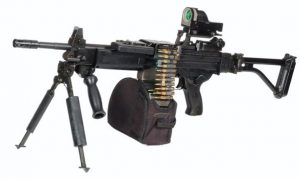
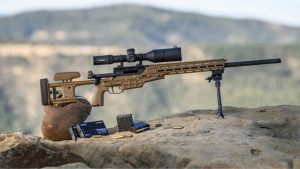
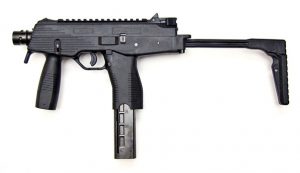
7.62 x 51 mm NEGEV Light Machine Gun SAKO TRG-42 sniper rifle MP 9
Conclusion
The Indian infantry will now be operating with small arms of different calibre and from different family systems. Going by the history, any weapon in small arms inventory would serve up to 15 to 20 years. Thus these weapons are to be the main stay till the turn of 2040 and beyond. There is no denying the fact that the weapons selected are amongst the best in the world that are best suited for the Indian environment. In that the AK 203 assault rifle for its robustness and easy maintainability will be adapted easily by the Indian soldier. The faith bestowed upon the existing AK 47 in operation by our soldier will form the corner stone in adaptation of AK 203 as his best buddy in war. Thus it can be authoritatively said that India has found a reliable assault rifle to see through the next two decades.
Disclaimer
The opinions expressed in this article are the author’s own and do not reflect the views of Chanakya Forum. All information provided in this article including timeliness, completeness, accuracy, suitability or validity of information referenced therein, is the sole responsibility of the author. www.chanakyaforum.com does not assume any responsibility for the same.
Chanakya Forum is now on . Click here to join our channel (@ChanakyaForum) and stay updated with the latest headlines and articles.
Important
We work round the clock to bring you the finest articles and updates from around the world. There is a team that works tirelessly to ensure that you have a seamless reading experience. But all this costs money. Please support us so that we keep doing what we do best. Happy Reading
Support Us





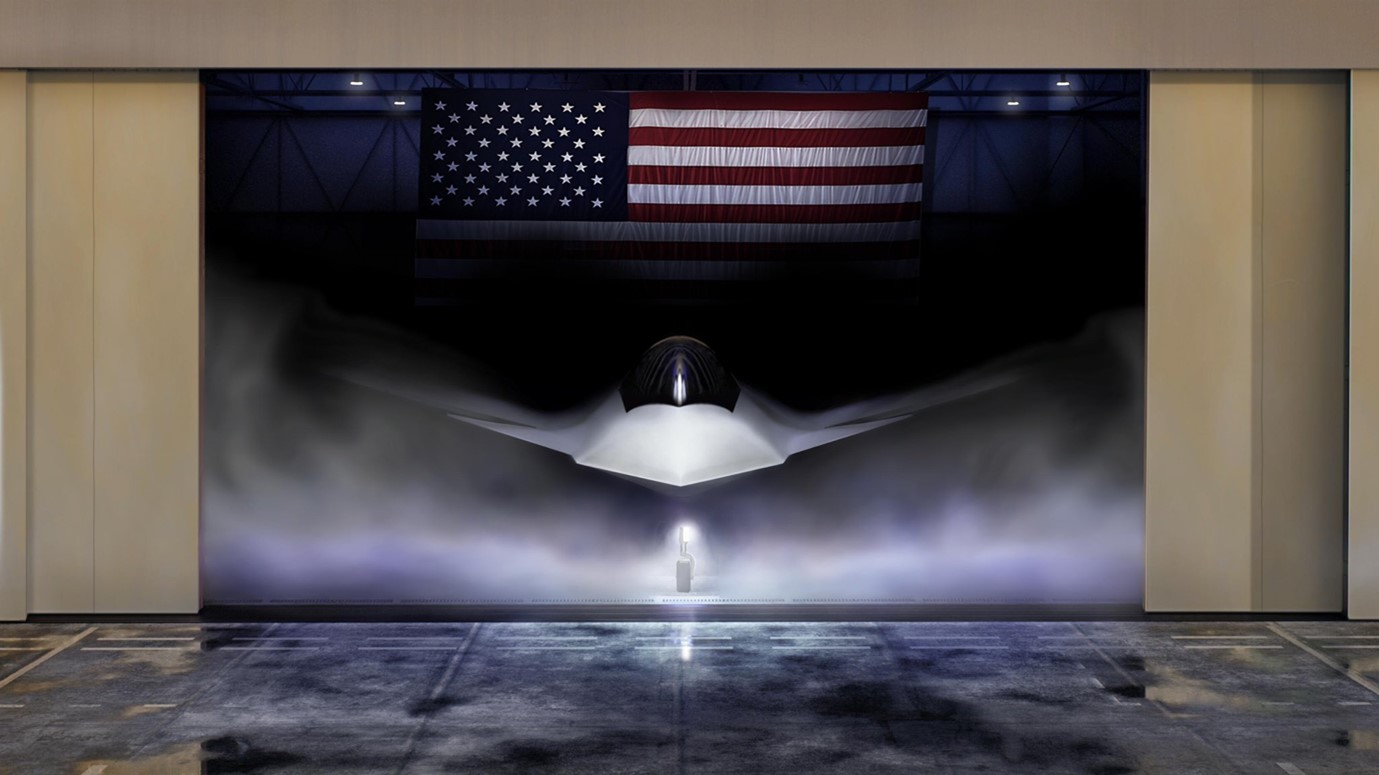









POST COMMENTS (0)